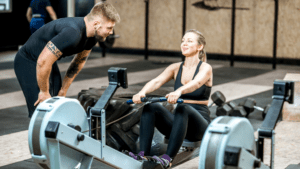
Breathing is an important everyday function that we do naturally over 20,000 times per day. By improving your breathing technique in day-to-day breathing, you can improve your breathing capacity and performance with exercise.
As we start to push our body with an exercise such as rowing, it can get complicated about when the right time is to breathe in and breathe out. Breathing while rowing can seem difficult, but with some practice, you will easily get it right.
It is worth taking the time and effort to learn the best methods of breathing while rowing, as well as day-to-day diaphragmatic breathing, as it will help you to be able to perform at a higher level. By improving your breathing technique, you can improve your rowing times by up to 2.2% - which may sound small, but can make a big difference at the end of a race!
We breathe over 20,000 times every single day. Every time you breathe in you are filling your lungs with air and the oxygen from the air moves into your bloodstream. This oxygen is so important for many vital functions in your body. At the same time, carbon dioxide moves from your blood into your lungs and then is exhaled when you breathe out.
Oxygen is needed for cells to help them to create energy so that your body can move and function, and push harder while you row. During this process of making energy, the cells emit carbon dioxide as a waste product. This carbon dioxide then moves from the cells into the bloodstream, through your heart, and into your lungs where it is breathed out.
When you breathe it is important to use your diaphragm, the strong dome-shaped muscle that is below your lungs, rather than just your accessory muscles around your lungs. The accessory muscles are made of intercostal muscles, abdominal muscles, and muscles around your neck and collar bone.
Your diaphragm is the most powerful muscle and should be the main muscle used when breathing. By training your diaphragm, you can improve your breathing technique which allows more oxygen to enter your lungs, and then your bloodstream. This oxygen then goes to the cells in your body, including your muscles. This is especially important with rowing as it is a very vigorous exercise, and by breathing correctly you can improve your rowing performance.
It is important to understand how to use your diaphragm when breathing at rest, to enable you to use it more effectively whilst under stress, as when exercising.
By practicing this technique on a daily basis, you can help to improve your rowing performance as it will help you to engage your powerful diaphragm to allow you to get more oxygen into your lungs. If you breathe more shallowly, by using mainly your accessory breathing muscles, you won’t get the full capacity of oxygen into your lungs.
When you breathe in, your lungs should expand as your diaphragm pulls down and acts like a vacuum sucking air into your lungs. You can feel this by placing your hands on your anterior chest, around your waist level. As you breathe in, you should feel your hands moving apart as your lungs expand.
When you breathe out, your diaphragm should come up, which helps to force the air out of your lungs. Your hands should then be drawn closer together as your lungs deflate and air is expelled from your lungs.
Rowing is a very vigorous form of exercise, and it is important to use your breath to help to enhance your rowing.
Rhythm in rowing is key. Once you have a hang of your strokes and your rowing style, then start to pay attention to your breath.
There are different schools of thought on when to exhale (breathe out) and when to inhale (breathe in) on your rowing stroke to enhance your breathing while rowing.
The most common is to:
You should be able to get one full breath (an exhale and an inhale) on every stroke if you are rowing at a gentle pace.
As you start to increase your rowing speed and rhythm, then your breath rate will need to increase to accommodate for this and you will need to get two breaths for every stroke. This will consist of an exhale as you finish the drive, an inhale to recover, a quick exhale and then inhale again just before the catch as you are all the way forward on the rower.
When you switch from a one breath to a two breath as your intensity increases is a personal choice. Practice your breathing while you are rowing, and you will find the right switch point for you.
It is best to practice this breathing technique on a slow rate of rowing, as this will help you to get the rhythm of movement and breath just right.
Breathing is a vital part of us staying alive every day. When you are exercising, such as rowing, you need to get your breathing right while rowing to get the most out of your training session and be able to push yourself that bit harder.
With a little bit of concentration, you can make the most of your breath while rowing and get the best workout you can.
